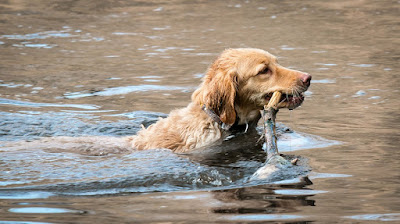I read about a study that revealed two remarkable squirrel facts.
1. Squirrels can remember hundreds of locations where they've stashed food.
2. When squirrels know that other squirrels are watching, they fake where they stash food, pretending to dig holes and put food inside and then, when not under observation, they sneak off and hide the food somewhere else.
Deception is a widely recognized mark of intelligence. Dog deception has been well documented. In controlled studies, dogs will deceive and manipulate people in order to get treats. Zoo keepers have lots of stories about how primates deceive humans, like the orangutan that hides something a human wants by tucking it in his cheek and then pretending to "help look" for the missing item.
Now you can add squirrels to the mix.
Yesterday, we watched a Douglas Squirrel exhibit some dramatic food behavior. (This in the Sierra foothills while we are still evacuated from Tahoe.)
The squirrel appeared to watch other squirrels and act one way if other squirrels were visible and another way if they weren't visible.
For example, this squirrel ran up the trunk of a 100-foot White fir. At the top, it cut off the cones (which grow near the very top of fir trees). The heavy, green cones came crashing down, slamming onto the ground with enough force to knock you out or kill you if your head was in the wrong place.
After many cones littered the ground, the squirrel came back down. He made a show of looking around the ground (I'm not kidding), and picked up a cone in his mouth (a real feat of strength considering the cone probably weighed a third or even half as much as the squirrel). He ran north into the forest, carrying the cone. In a minute, he came back with no cone.
He looked around again, picked up another cone, then ran off with that one, again to the north.
After several trips carrying cones to the north, he paused, looked around, then ran up the trunk of a nearby Ponderosa pine, also about 100 feet tall. Soon he came back down the Ponderosa pine carrying a White fir cone. It seemed like he was moving a bit slower than before. When he got to the ground, which was still littered with white fir cones he'd previously cut and dropped, he looked around (looking for other squirrels?) and ran off to the east. We saw him dig a small hole under a Black oak tree, bury the cone, then run back.
The squirrel repeated this process, running up the Pondersa pine, coming back down with a White fir cone, pausing, heading east, and burying the cone under an oak.
After a few trips, he went back to his previous behavior. He ran up the White fir, cut and dropped some cones, came down the fir, picked up a cone that he'd already dropped from high up, and ran into the forest to the north.
We tried to make sense of this strange behavior, picking up cones off the ground and running to the north, then carrying cones down from the tree canopy and burying them to the east. Add into the mix that he used a Ponderosa pine as his highway to the sky whenever he wanted to carry a white fir cone down instead of merely picking it up off the ground.
There might be many explanations. But the one that made the most sense to us was deception. His obvious moves of picking up cones off the ground were followed by carrying them north.
The sneakier moves of going up a Ponderosa pine, leaping across from the top of the pine to the top of the fir to get a cone, and leaping back, seemed very much like a routine designed to make his varied efforts less obvious to any less industrious squirrels who might want to simply steal his cache rather than going to all the work themselves.
Intelligence? Major league by my judgment.






